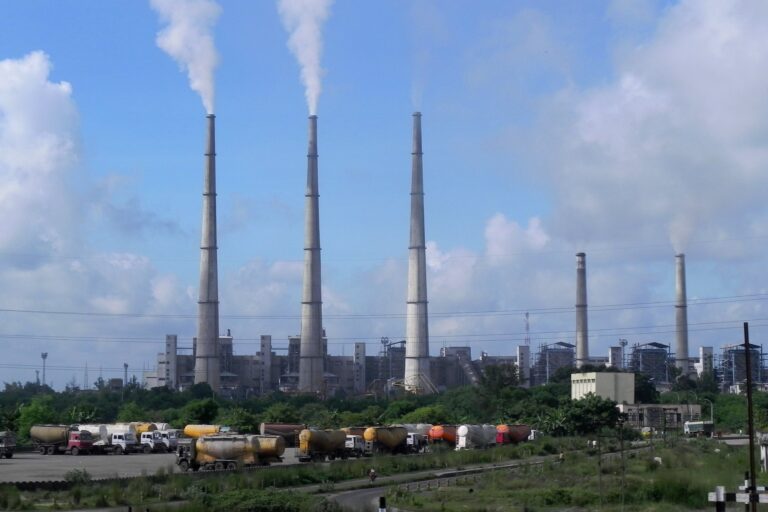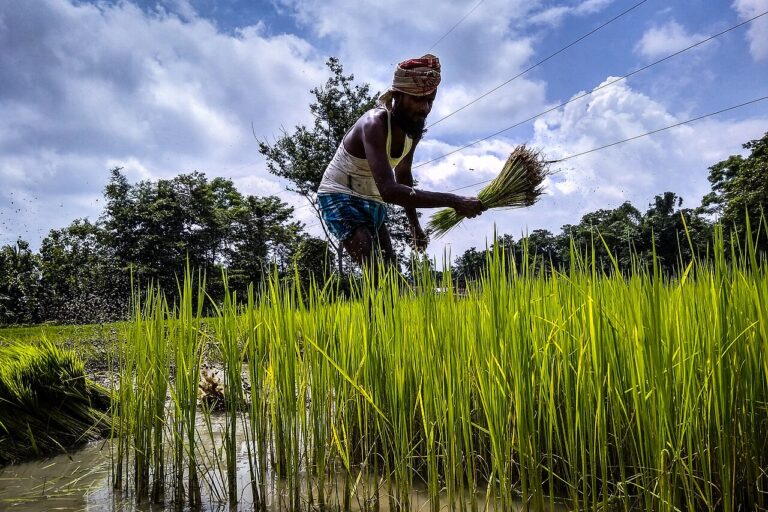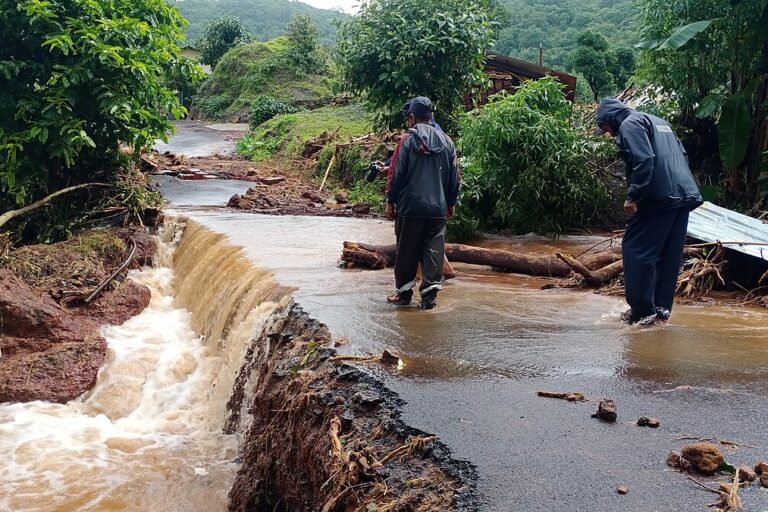The central government has granted widespread exemptions to thermal power plants from complying with air pollution emissions norms, in a move experts say could be detrimental to public health.
On July 11, the Ministry of Environment, Forests, and Climate Change issued a notification exempting thermal power plants which are due to retire by 2030 from complying with sulphur dioxide emissions standards, as long as they declare their year of retirement to the Central Pollution Control Board and the Central Electricity Authority.
As per the notification, only ‘Category A’ plants – those located within 10 kilometres of the National Capital Region and other cities with populations exceeding one million – need to comply with sulphur dioxide emissions standards by December 2027.
Plants that have obtained environmental clearance and are located within a 10-kilometre radius of other critically polluted areas – ‘Category B’ – have the option of complying with norms by December 2028 or appealing to the centrally-appointed Expert Appraisal Committee for exemption. Whether up-and-coming plants in this category need to comply with emissions norms will be determined through the environmental clearance process, the notification says.
The most dramatic change is for ‘Category C’ plants that are neither located close to big cities nor to critically polluted areas, but which make up the vast majority of thermal power plants in the country. The notification states that these plants needn’t comply with sulphur dioxide standards at all, as long as the height of their chimneys (stacks) meet required limits.
Once released into the atmosphere, sulphur dioxide can react with other pollutants to form hazardous PM2.5 particles. Between June 2022 and May 2023, thermal power plants released approximately 4,327 kilotonnes of sulphur dioxide.
Non-retiring and non-compliant plants will have to pay environmental compensation of up to Rs. 0.40 per unit of electricity generated, depending on the tenure of non-compliance.
The government has said the changes were introduced because of limited availability of flue gas desulphurisation (FGD) technologies, supply chain issues, price escalations, and “low sulphur dioxide concentration in ambient air” — all reasons that have been challenged by policy experts and scientists.
Previously, all thermal power plants, regardless of category, were mandated to meet emissions standards by installing FGD technology.
“Granting such a large-scale exemption undermines the effectiveness of the emission standards and poses a serious risk to public health and environmental sustainability,” said Shreya Verma, programme manager at the Centre for Science and Environment, in a statement.
Banner image: A power plant in Kolkata. Representative image by Smeet Chowdhury via Flickr (CC BY 2.0).

An artificial intelligence-based drought advisory tool developed in India was launched on July 7 at the AI for Good Summit in Geneva, an event hosted by the United Nations and co-convened with the Government of Switzerland. The AI for Good Summit is a global event organised by the International Telecommunication Union (ITU), a specialised agency of the United Nations, in partnership with over 40 UN organisations and other international partners.
The tool, named SukhaRakshak AI, is designed to provide early warning and location-specific guidance for managing drought. It has been developed by the International Water Management Institute (IWMI) in partnership with the Indian Council of Agricultural Research – Central Research Institute for Dryland Agriculture (ICAR-CRIDA) and the CGIAR Climate Action Program.
The pilot phase of the tool will start next month. The tool combines satellite data, seasonal and short-term weather forecasts, and district-level drought contingency plans.
The system uses Gemini 2.0 Flash, retrieval-augmented generation (RAG), and integrates data from sources including SADMS, Google Earth Engine, and global forecast systems such as NOAA, GEFS, and CFS, according to a press release issued by IWMI. “The system is intended for use by smallholder farmers, agricultural extension workers, and local authorities,” the release stated. “It delivers customised advisories through a chatbot interface, using AI models that draw from climate, weather, and remote sensing data.”
The tool seeks to address long-standing challenges in drought preparedness in India, where over 120 million smallholder farmers face periodic water stress and crop failures.
It aims to bridge the gap between early warning and early action by providing practical, timely advice tailored to the user’s location and role, said the press release.
SukhaRakshak AI delivers text and voice-based drought advisories in over 22 Indian languages through integration with AI4Bharat and Sarvam AI, ensuring access for rural users with limited literacy.
A key feature of the tool is its ability to deliver voice- and text-based advisories via mobile applications, WhatsApp, SMS, and IVR calls, making it accessible to users with low digital literacy or limited internet connectivity. The platform also incorporates a feedback loop, allowing users to share field-level observations and improve forecast accuracy over time.
Field trials are scheduled to begin in Odisha and Tamil Nadu in August 2025, with initial deployment targeting agricultural extension officers and local drought authorities. Wider access for farmers via mobile and web platforms is planned following the pilot phase.
Banner image: Farmers planting millets in Odisha. Image by Tanmoy Bhaduri/IWMI.

In a significant step towards expanding the green cover of Bengaluru city, the Karnataka government announced a new biodiversity park. To be set up on 154 acres of forest land in the Madappanahalli reserve forest near Yelahanka, close to Kempegowda International Airport, the biopark, once completed, is expected to become a major public space and tourist attraction in the city’s northern outskirts.
Announcing the initiative in early June, the state’s Forest, Ecology and Environment Minister Eshwar Khandre said the park would be the city’s first large-scale green space after a century, since the creation of Cubbon Park in 1870. Expected to be Bengaluru’s third major park, after Lalbagh Botanical Garden and Cubbon Park, the forest land was recently reclaimed from the Karnataka Forest Development Corporation (KFDC). The land was formally handed back to the Forest Department in the minister’s presence during the announcement.
The Principal Chief Conservator of Forests (PCCF) Meenakshi Negi informed Mongabay India that the project is still in its conceptual phase. “We are in the process of planning it and are actively seeking inputs from experts and the public,” she said. “The idea is to develop an interactive, accessible green space, something on the lines of Lalbagh.”
The site is currently dominated by eucalyptus, a non-native species that will be removed in line with the state ban on cultivating eucalyptus that has been effective since 2017. Native and Western Ghats-endemic species such as bilva, honne, banyan and peepal are expected to replace them. According to Khandre, the area already supports around 800 trees of native varieties.
The proposed features of the biopark include: Basaveshwara medicinal garden, Kempegowda mini-zoo, Dr. B. R. Ambedkar aviary, Indira Gandhi biopark, Saalumarada Thimmakka tree park, a butterfly park, a germplasm bank, a bamboo grove, an arboretum and some water features.
Negi informed that a detailed project report (DPR) was being prepared, incorporating public and expert input. According to Khandre, the park is expected to be completed within the next two to three years, with ₹20 crore sanctioned for the first phase of its development.
Banner image: Cubbon park. Representative image by Divya Kilikar/Mongabay.

If the latest antivenom study is any indication, the next breakthrough treatment for snakebites in India could come in the form of a pill. It could be more effective, affordable, and easily accessible than existing options.
In a landmark study, researchers at the Evolutionary Venomics Lab, Centre for Ecological Sciences, Indian Institute of Science, Bengaluru, tested two repurposed small-molecule inhibitors (SMIs) — varespladib and marimastat — for their ability to neutralise venom from the Russell’s viper (Daboia russelii) across different regions of India. Small-molecule inhibitors are a class of drugs that work by targeting and blocking specific molecules, primarily proteins, involved in various cellular processes. These drugs were originally developed to treat conditions such as cancer and cardiovascular disease, which also means they have already undergone human clinical trials for those uses.
Scientist and professor Kartik Sunagar at the Centre for Ecological Sciences, who led the study, told Mongabay India that unlike antivenoms, which have never undergone formal clinical trials despite being widely used in countries like India, these drugs have already passed safety and toxicity assessments. “So, we only needed to test their efficacy for snakebites,” he says.
The neutralisation experiment on one of India’s big four medically significant snakes, Russell’s viper, proved to be the clincher.
The venom of this snake is dominated by three major toxin families: SVMP, PLA₂, and SVSP, which occur in varying proportions across its geographical range. The scientists assessed the effectiveness of the two SMIs, varespladib and marimastat, in countering the toxic effects of Russell’s viper venom sourced from diverse regions. “We’ve demonstrated that a specific combination of these two drugs provides complete protection against Russell’s viper in almost every corner of India. We’ve tested them across 10 different sites in 10 different states,” Sunagar explains.
The study found that in most D. russelii populations, a single small-molecule inhibitor could neutralise lethal venom effects in preincubation tests, and in some cases, it didn’t matter which toxin family — PLA₂ or SVMP — was blocked. This is surprising, the paper notes, given the complex and variable mix of toxins typically found in snake venoms.
The study offers several advantages of the treatment. A major benefit is that these are oral drugs. “Someone bitten in a rural area can take the pill immediately, buying time or potentially avoiding antivenom altogether,” Sunagar adds. They’re also inexpensive to produce, being lab-synthesised chemicals that don’t require animals, making them a scalable alternative to conventional antivenom.
Banner image: A Russel’s viper. Image by CHANDRANUJ via Wikimedia Commons (CC BY-SA 4.0).

If global warming were to stabilise at current levels — 1.2°C above pre industrial levels — the world would still lose 39% of its glaciers compared to 2020, leading to 113 mm sea-level rise, a new study with a novel approach to data finds. “This substantial present-day committed mass loss highlights that today’s glaciers are strongly out of balance with current climatic conditions due to their long response times,” the study says.
Meeting the limits of the Paris Agreement (limiting warming up to 1.5 and 2°C) could mean committing to 47% and 63% of glacier mass loss relative to 2020 levels. The findings — three times larger than most other projections — is the result of an approach using eight glacier models across 80 climate scenarios.
“One of the key strengths of our study is that we were able, for the first time, to project global glacier evolution over multi-centennial timescales, and did so using eight models instead of one or two,” said Harry Zekollari, lead author of the study from Vrije Universiteit Brussel in a statement. “Most glacier studies stop at 2100, which is problematic when simulating the long-term impact of today’s climate policies, given the long-term response of glaciers over time,” he added.
Glaciers likely to see the most loss are located within smaller elevation ranges, at lower latitudes, because there is limited scope to adapt by retreating to higher elevations.
At current levels of warming, the Arctic Canada South is projected to lose the most mass (around 85%), followed by Western Canada and the United States (74%), Scandinavia (66%) and the Russian Arctic (65%). Regions like South Asia West, Central Asia, and New Zealand will see relatively fewer losses – 5%, 12%, and 15% – because they’re present in areas with higher elevation range.
The study also demonstrates the importance of extending warming scenarios to multi-century timelines. It would take glaciers in the Subantarctic and Antarctic Islands — fortressed by rugged terrain and high latitudes — 800 years to lose 80% of their mass under a 1.5°C scenario, it finds.
By contrast, the fastest responding regions are Central Europe, Caucasus and Middle East, Low Latitudes, and New Zealand, which “need less than five decades for 80% changes to occur,” says the study.
Current and near-term policies aimed at mitigating global warming “will play a decisive role in shaping the future evolution of glaciers, influencing not only immediate glacier changes but also those that will unfold over multi centennial timescales,” the study concludes.
Banner image: Caves in the Morteratsch-Pers glacier complex. Image by Lander Van Tricht (ETH Zurich/Vrije Universiteit Brussel).

In a step towards strengthening food security amid rising climate pressures, researchers at the Indian Agricultural Research Institute (IARI) and the Indian Institute of Rice Research (IIRR), under the Indian Council of Agricultural Research (ICAR), have developed two genome-edited rice varieties: DRR Dhan 100 (Kamala) and Pusa DST Rice 1.
Developed using the CRISPR-Cas9 genome editing technique, these rice varieties aim to boost yield and resilience to drought and salinity — critical concerns for Indian agriculture facing the impacts of climate change. Kamala, developed by ICAR-IIRR in Hyderabad, is derived from the popular Samba Mahsuri variety and offers high yield potential and improved stress tolerance. Pusa DST Rice 1, from ICAR-IARI in New Delhi, is based on Cotton Dora Sannalu and is designed for drought and salt tolerance.
Unlike genetic modification, which involves inserting foreign genes, genome editing makes precise changes within the plant’s own DNA. “In genome editing, mutations are induced at specific sites where change is needed. These are internal and guided changes — a modern, targeted way to induce genetic mutations that also occur in nature, but with precision for specific outcomes,” says Viswanathan C., Joint Director (Research) at IARI.
The varieties were developed using Site-Directed Nuclease techniques (SDN-1 and SDN-2), which ICAR scientists say are safe and comparable to natural mutations. These new rice lines are expected to help farmers cope with environmental stressors while contributing to sustainable agricultural practices.
Banner image: A farmer harvests paddy. Representative image by Indranil Gayan via Wikimedia Commons (CC BY-SA 4.0).

Researchers at Nagaland University have identified two stingless bee species — Tetragonula iridipennis Smith and Lepidotrigona arcifera Cockerell — as efficient pollinators that could significantly boost polyhouse farming in India. Their study found these bees successfully pollinated about 10 crops under greenhouse conditions, including chilli, cucumber, watermelon, and pumpkin.
Avinash Chauhan, principal investigator (AICRP Honeybees & Pollinators), explains: “Stingless bees have a limited range of 50-100 metres and tolerate heat up to 40°C. In contrast, the rock bee (Apis dorsata), a major pollinator in open fields, has a much wider range and cannot be confined to polyhouses.”
Their stingless nature and floral fidelity make them ideal for enclosed farming. “They return to the same flower until the nectar is fully harvested, making them excellent pollinators,” Chauhan adds. The study showed a 29.46% increase in fruit set in king chilli and significant gains in seed weight when pollinated by stingless bees.
India is already facing a sharp decline in invertebrate pollinators. With over half of all crop yields dependent on insect pollinators, this loss is concerning — especially as agriculture accounts for 18.2% of India’s GDP and supports 42.3% of the population.
As agricultural land shrinks due to urbanisation, polyhouse farming is gaining traction. Stingless bees — once considered tropical — are now found in temperate zones too, with six of India’s 27 species identified in Nagaland.
Besides pollination, these bees offer farmers the added benefit of medicinal honey. Chauhan’s team has designed brood boxes to prevent fermentation and allow separate honey storage. Future research will focus on global crops and refining honey extraction and analysis techniques, including melissopalynology.
Banner image: A Tetragonula iridipennis bee. Image by Ramesh Kunnappully via Wikimedia Commons (CC BY-SA 4.0).

Corporations, governments, and political parties are intentionally spreading inaccurate or misleading narratives about climate change, according to a new global assessment of information integrity about climate science. The fallout is a decline in public trust in science, weaker policy coordination, and scientific denialism fuelling political inaction, said the International Panel on Information Integrity’s systematic review of 300 peer-reviewed studies published between 2015 and 2025.
A decade of research reviewed showed that “strategic scepticism” about climate change is replacing climate denialism and that policymakers are key targets of the misinformation. The review also noted that “misinformation leads people to lose faith in climate science and in a hopeful future for themselves.”
The authors of the report highlighted that there is a severe gap in research on climate information integrity in the Global South, where impacts are likely to be significant but poorly documented. “Out of the papers we reviewed, there was only one out of 300 carefully studied papers, that dealt with the entire content of Africa,” said Klaus Bruhn Jensen, Chair of the International Panel on the Information Environment’s (IPIE) Scientific Panel on Information Integrity about Climate Science, at the online report launch, while giving an example of the lack of research on the issue from the Global South. IPIE is a consortium providing actionable scientific knowledge on threats to the global information environment. Jensen highlighted the study finding that policymakers should secure more comparative evidence, especially from countries in the Global South, about climate information integrity.
The review also recognises that climate science knowledge and discourse has been “historically articulated by intellectual elites in the Global North” which can create barriers for communities in the countries that rely on indigenous knowledge in their daily lives. For example, the review refers to a 2015 study that found “state authorities in the Indian Himalayas have wrongfully labelled local environmental narratives as conspiracy theories” and pointed to perspectives including intersectional research to recognise local solutions to the global climate crisis.
The review recommends legislation and regulation, litigation against greenwashing and misinformation, forming coalitions to counter disinformation campaigns, and strengthening scientific and media literacy among citizens and policymakers.
Information integrity refers to the accuracy, reliability, and trustworthiness of information, especially in how it is produced, shared, and received. In the run up to COP30, the Global Initiative for Information Integrity on Climate Change, first established in in 2024 by the UN, UNESCO and the Brazil government, is developing a network of partners to research and report on how mis/disinformation, ranging from conspiracy theories to orchestrated campaigns, is affecting climate action, particularly in the Global South.
Banner image: Roads destroyed during the 2021 floods in Maharashtra. Representative image. Misinformation about climate change leads people to lose faith in climate science and in a hopeful future for themselves, finds a new report. Image by Varsha Deshpande via Wikimedia Commons (CC BY-SA 4.0).





